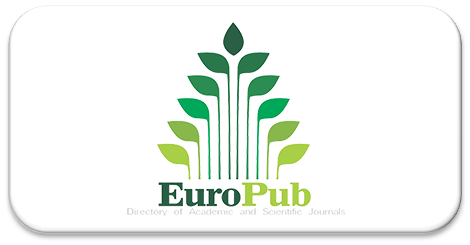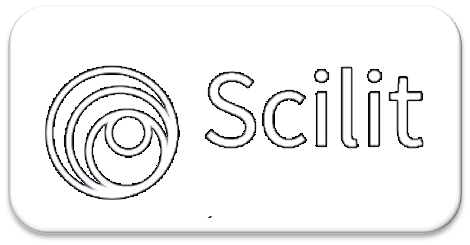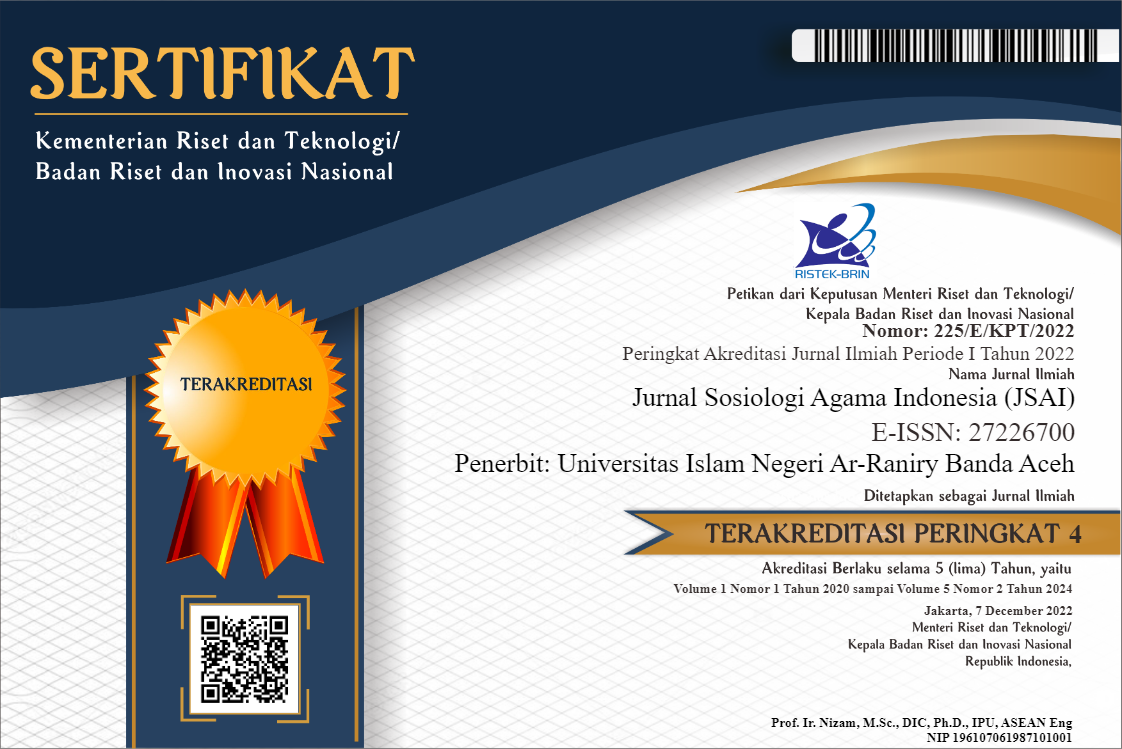Perubahan Fungsi dan Kedudukan Meunasah dalam Kehidupan Generasi Muda Aceh
The Changes in Meunasah's Functions and Roles in the Acehnese Young Generation
Abstract
Meunasah underwent a drastic change in its function in the lives of the young generation of Aceh. Therefore, it is important to examine the changes in the function of the Meunasah in the life activities of the young generation in seeing the urgency of the Meunasah as a community centre in supporting the development of young generations in the face of the globalization. This qualitative study uses interview methods, observation and documentation in collecting data and using interactive analysis to analyze the findings. The results showed that the shift in the function of the Meunasah in the young generation of Aceh was caused by social changes that occurred after the conflict and the tsunami disaster. This situation is strengthened by the condition of the Meunasah that does not keep up with the development of information technology so that it is unable to answer the needs of the young generation who are bound by technology. Therefore, it is necessary to modernize the Meunasah environment in order to meet the technological needs of the young generation, so that the Meunasah can still function as a community center in preparing the young generation of Aceh.
AbstrakMeunasah mengalami perubahan fungsi yang drastis dalam kehidupan generasi muda Aceh. Oleh karena itu menjadi penting untuk mengkaji tentang perubahan fungsi meunasah dalam aktivitas kehidupan generasi muda dalam melihat urgensitas meunasah sebagai community center dalam menopang perkembangan generasi muda dalam menghadapi globalisasi dunia. Penelitian kualitatif ini menggunakan metode wawancara, observasi dan dokumentasi dalam pengumpulan data dan menggunakan analisis interaktif dalam menganalisis temuan dalam penelitian ini. Hasil penelitian menunjukkan pergeseran fungsi meunasah dalam kehidupan generasi muda Aceh disebabkan oleh perubahan sosial yang terjadi pasca konflik dan bencana tsunami yang melanda Aceh. Kondisi ini dikuatkan dengan keadaan institusi meunasah yang tidak mengikuti perkembangan teknologi informasi sehingga tidak mampu menjawab kebutuhan hidup generasi muda yang terikat dengan teknologi. Oleh karena itu perlu dilakukan upaya modernisasi di lingkungan meunasah agar dapat memenuhi kebutuhan teknologi di kalangan generasi muda, sehingga meunasah tetap dapat difungsikan sebagai community center dalam menyiapkan generasi muda Aceh yang beriman dan berkemajuan.
References
Afrizal, Kepala Mukim. 2022. “Wawancara tentang Kondisi Sosial Masyarakat Kemukiman Lamteungoh di Lamteungoh, tanggal 16 Februari.”
Baharuddin, Tokoh Masyarakat Gp. Lamteungoh. 2022. “Wawancara tentang Aktifitas Pengajian Pemuda Gampong.”
Djalil, Muslim A. t.t. “Meunasah: Pusat Peradaban Masyarakat Aceh.” http://www.atjehcyber.net/2011/06/meunasah-pusat-peradaban-masyarakat.html. Diambil 14 April 2020 (http://www.atjehcyber.net/2011/06/meunasah-pusat-peradaban-masyarakat.html.).
Hassan, Soraya Masthura, Fahmi Fefriandi, Cut Azmah Fithri, dan Sisca Olivia. 2021. “Tipologi Geometri Bangunan Meunasah di Kecamatan Indrajaya Kabupaten Pidie, Aceh.” Jurnal Arsitektur ARCADE Vol. 5, No. 3:272–77.
Ibrahim, Muhsinah. 2014. “Dayah, Mesjid, Meunasah Sebagai Lembaga Pendidikan dan Lembaga Dakwah di Aceh.” Jurnal Al-Bayan Vol. 21, No. 30,:21–34.
Ismail, Badruzzaman. 2021. “Fungsi Meunasah Sebagai Ikon Budaya Adat Aceh.” Sekretariat Majelis Adat Aceh. Diambil 5 Februari 2022 (https://maa.acehprov.go.id/berita/kategori/adat-istiadat/fungsi-meunasah-sebagai-ikon-budaya-adat-aceh).
Mahdi, Guru dan Mantan Tuha Peut Gp. Meunasah Tuha. 2022. “Wawancara tentang Aktifitas Masyarakat di Meunasah Gampong.”
Meutia, Cut Intan, Chery Julida Panjaitan, dan Fadhillah Wiandari. 2022. “Value Shifting at Meunasah in Langsa in Social Context.” Jurnal Education and Development Vol. 10, No. 1:116–23.
Miles, Mattew B., dan Michael Huberman. 1984. Qualitative Data Analysis: A Sourcebook of New Methods. Beverly Hills, California: Sage Publication Inc.
Muslim. 2020. “Meunasah: Lembaga Pendidikan Islam Tradisional Aceh.” Jurnal At-Tafkir Vol. 13, No. 2:173–86.
M.Zein, Tuha Peut. 2022. “Wawancara tentang Aktifitas Pemuda di Kemukiman Lamteungoh.”
Rahman, Aulia, Hanafiah, dan Madhan Anis. 2017. “Penguatan Pendidikan di Meunasah Sebagai Benteng Keimanan Masyarakat Aceh: Suatu Studi di Kota Langsa, Aceh.” Jurnal Seuneubok Lada Vol .4, No.1:1–10.
Sabirin. 2014. “Meunasah dan Ketahanan Masyarakat Gampong: Kajian Kritis Terhadap Power of Local Wisdom.” Jurnal Ilmiah Peuradeun Vol. 2, No. 02:105–26.
Sahlan, Muhammad, Ade Ikhsan Kamil, Iromi Ilham, and Khairul Amin. 2021. “‘Dari Ainal Madhiah Ke Si Kakek Merah’ Ethnography of the Community Response Towards Covid-19 Pandemic.” 495(ICoSPOLHUM 2020):209–14. doi: 10.2991/assehr.k.210125.035
Solichin, Mujianto. 2015. “Perkembangan Pendidikan Meunasah dan Dayah di Aceh.” Dirasat: Jurnal Manajemen dan Pendidikan Islam Vol. 1, No. 1:124–51.
Syukri, Tokoh Pemuda Gp. Meunasah Tuha. 2022. “Wawancara tentang Aktifitas Pemuda di Meunasah Gampong.”
Wahid, Umaimah. 2013. “The Function of Meunasah in Social Cultural Communication Process within Acehness Society.” Journal of Human Capital Development Vol. 6, No. 1:151–67.
Copyright (c) 2022 Azwarfajri Azwarfajri

This work is licensed under a Creative Commons Attribution-NonCommercial-ShareAlike 4.0 International License.
- Authors retain copyright and grant the journal right of first publication with the work simultaneously licensed under an Attribution-NonCommercial-ShareAlike 4.0 International (CC BY-NC-SA 4.0) that allows others to share the work with an acknowledgment of the work's authorship and initial publication in this journal.
- Authors are able to enter into separate, additional contractual arrangements for the non-exclusive distribution of the journal's published version of the work (e.g., post it to an institutional repository or publish it in a book), with an acknowledgment of its initial publication in this journal.
- Authors are permitted and encouraged to post their work online (e.g., in institutional repositories or on their website) prior to and during the submission process, as it can lead to productive exchanges, as well as earlier and greater citation of published work.
















.png)






2.png)






